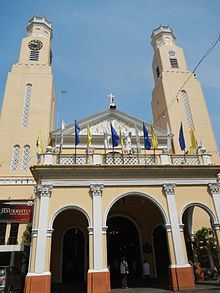Founded 1580 Archbishop Luis Antonio Tagle | Consecrated 1599, 1999, 2011 Dedication Ferdinand III of Castile | |
 | ||
Cult(s) present Nuestro Santo Padre Jesús del Sepulcro Materials Sand, Gravel, Cement, Mortar Similar Paco Park, Santa Ana Church, Ermita Church, Santa Cruz Church, Binondo Church | ||
The San Fernando de Dilao Parish Church (Tagalog: Simbahang San Fernando de Dilao ng Paco; Spanish: Iglesia Parroquial de San Fernando de Dilao) is a Roman Catholic church located in Paco, Manila, Philippines, honoring the Spanish king Saint Ferdinand III of Castile. From February 7, 2012 to April 9, 2014, the parish was used as the Pro-Cathedral of the Archdiocese of Manila, during the structural renovations of the Cathedral-Basilica of the Immaculate Conception. The church inside is notable for its romanesque-Byzantine interior with recently Italian Baroque styled Altar, most notably the Latin inscriptions similar in style to Saint Peter's Basilica in Vatican City.
Contents
The church is currently administered by its parish priest, Rev. Msgr. Rolando R. de la Cruz. In addition, the church provides active medical, dental and ENT charitable services for its poor parishioners within the community.
History
In 1580, the first church built was made of nipa and bamboo and was originally dedicated to Our Lady of Purification. Fr. Juan de Garrovillas of the Franciscan order has rebuilt the church using stone materials in 1599-1601. The neighbourhood's name Dilao refers to a local shrub once used to dye textiles yellow (current Filipino orthography: diláw, "yellow").
In October 3, 1603, the church was attacked and burned by Chinese during riots. It was repaired in 1606 and rebuilt with stone materials by Don Francisco Gómez de Arellano. Invading troops from the Kingdom of Great Britain burnt down the church in 1762 during their occupation of the city as part of the Seven Years' War. In 1791, a temporary church made of bamboo and nipa was erected.
Fr. Joaquín Segui constructed the stone convento in 1793-1794 which was repaired in 1854. In 1880, this convent was ruined by an earthquake. Fr. Bernardo dela Concepción began the construction of a new church in 1809 and completed in 1814. It was called Antigua Iglesia de Paco ("Old Paco Church") while Fr. Miguel Richar built the belfry from 1839-1841. Earthquakes again destroyed the church in 1852 and 1880.
Fr. Gilberto Martín began the reconstruction of the church in 1881. When this was about to be completed, a typhoon in 1892 partly destroyed the church. In 1896, Fr. Martín completed the reconstruction work.
On February 5, 1899, the church was bombed and completely burned during the Philippine-American War. Belgian priests of the Congregatio Immaculati Cordis Mariae took possession of the burnt church in 1909 and in the following year, Fr. Raymundo Esquinet worked for the construction of a temporary concrete church at a site near the old church's ruins. In 1924, Fr. José Billie proposed a newer and much larger church, and the cornerstone of the present church was laid in August 1931.
On February 7, 2012, the church was designated as pro-cathedral of the Archdiocese of Manila until structural renovations on the Cathedral-Basilica of the Immaculate Conception were completed on April 9, 2014.
A notable longstanding custom of Paco Church today is the devotion to Nuestro Santo Padre Jesús del Sepulcro. Also known as Santo Entierro, the image is a statue of the dead Christ encased in a special wood and glass casket, and is a common icon in Filipino churches.
Architecture
The church facade, flanked by tall, twin belfries, possess a Neoclassical style of architecture. The terraced, arcaded portico provides a transitional entrance to the church. The Corinthian columns on the first and second levels of the church plus the triangular pediment give the façade the classic character.
